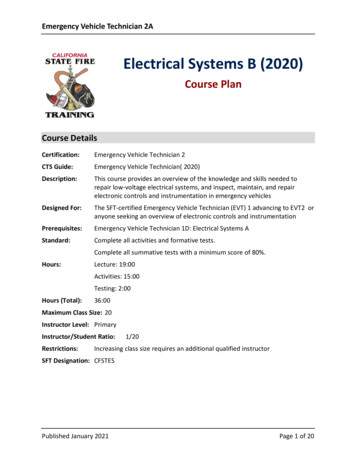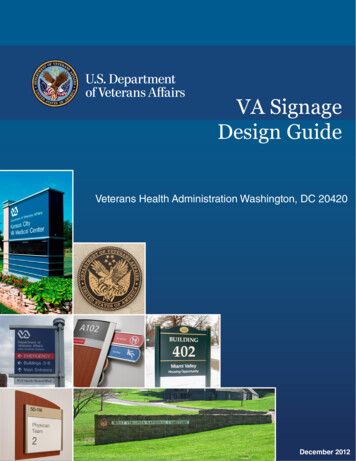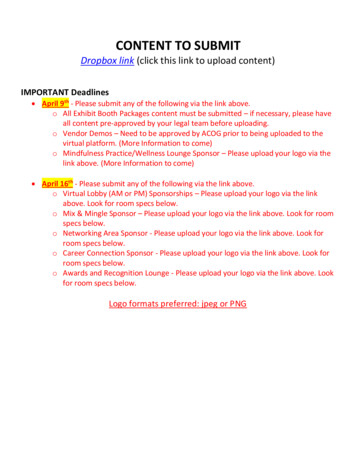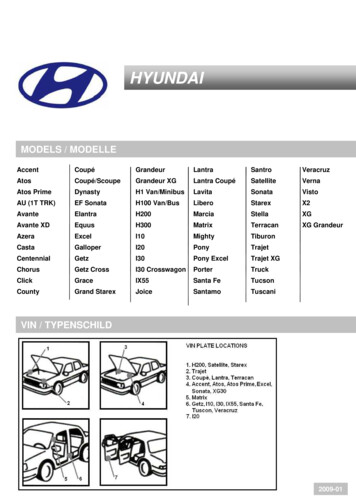
Transcription
Emergency Vehicle Technician 2ADocument TitleSFT LogoElectrical Systems B (2020)Course PlanCourse DetailsCertification:Emergency Vehicle Technician 2CTS Guide:Emergency Vehicle Technician (2020)Description:This course provides an overview of the knowledge and skills needed torepair low-voltage electrical systems, and inspect, maintain, and repairelectronic controls and instrumentation in emergency vehiclesDesigned For:The SFT-certified Emergency Vehicle Technician (EVT) 1 advancing to EVT 2 oranyone seeking an overview of electronic controls and instrumentationPrerequisites:Emergency Vehicle Technician 1D: Electrical Systems AStandard:Complete all activities and formative tests.Complete all summative tests with a minimum score of 80%.Hours:Lecture: 19:00Activities: 15:00Testing: 2:00Hours (Total):36:00Maximum Class Size: 20Instructor Level: PrimaryInstructor/Student Ratio:Restrictions:1/20Increasing class size requires an additional qualified instructorSFT Designation: CFSTESPublished January 2021Page 1 of 20
Emergency Vehicle Technician 2AInstructor ResourcesTo teach this course, instructors need: Medium/Heavy Duty Truck Electricity and Electronics (1st edition)o Classroom manual and shop manualo Author: Sulev Ouno ISBN 13: 978-0827370067o One copy of each item per student a personal copy for the instructor Student Supplemento Provided by California Fire Mechanics Academy, Inc. Personal protective equipment (PPE)Online Instructor ResourcesThe following instructor resources are available online aining/cfstes-professional-certification/: Activity 2-2: Testing Electrical Systems and Electronic ControlsStudent ResourcesTo participate in this course, students need: Medium/Heavy Duty Truck Electricity and Electronics (1st edition)o Classroom manual and shop manualo Author: Sulev Ouno ISBN 13: 978-0827370067o Provided by instructor for in-class use Student Supplemento Provided by California Fire Mechanics Academy, Inc. Personal protective equipment (PPE)o Student must bring to class Digital multimeter (DVOM)o Student must bring to classFacilities, Equipment, and PersonnelThe following facilities, equipment, or personnel are required to deliver this course:Facilities Standard classroom equipped for 20 students Projector with appropriate laptop connections Wifi/Internet access Outdoor space for emergency response vehicle with a clear perimeter for studentactivitiesPublished January 2021Page 2 of 20
Emergency Vehicle Technician 2AEquipment Emergency response vehicle Schematicso Digital or physicalo Must correspond to an onsite emergency response vehicle Low-voltage electrical systems (test, calibration, and diagnostic equipment, and tools)o Digital voltmeter (DVOM)o Ammetero Battery testerso Power probes / powered test lightso Test lightso Test leadso Digital storage oscilloscopes (DSO)o Scannerso Relay substitution deviceo Soldering equipmento Crimping equipmento Remote start switcheso Remote power supplieso Wire strippers Electronic controls and instrumentation (test, calibration, and diagnostic equipment,and tools)o Working alternator modelo Working starter modelo Working multiplex model Activity 2-1o Four different solenoids (at least four sets of each)o DVOMo Power Probe or jumper test lead Activity 2-2: Testing Electrical Systems and Electronic Controlso DVOMo Ammetero Fuse-resistance chartPublished January 2021Page 3 of 20
Emergency Vehicle Technician 2AUnit 1: IntroductionTopic 1-1: Orientation and AdministrationTerminal Learning ObjectiveAt the end of this topic, a student will be able to identify facility and classroomrequirements and identify course objectives, events, requirements, assignments, activities,resources, evaluation methods, and participation requirements in the course syllabus.Enabling Learning Objectives1. Identify facility requirements Restroom locations Food locations Smoking locations Emergency procedures2. Identify classroom requirements Start and end times Breaks Electronic device policies Special needs and accommodations Other requirements as applicable3. Review course syllabus Course objectives Calendar of events Course requirements Student evaluation process Assignments Activities Required student resources Class participation requirementsDiscussion Questions1. What is a formative test? What is a summative test?Activities1. To be determined by the instructor.Topic 1-2: Emergency Vehicle Technician Certification ProcessTerminal Learning ObjectiveAt the end of this topic, a student will be able to identify different levels in the EmergencyVehicle Technician certification track, the courses and requirements for State Fire Training(SFT) Emergency Vehicle Technician (EVT) certification, and be able to describe the capstonetask book and testing process.Published January 2021Page 4 of 20
Emergency Vehicle Technician 2AEnabling Learning Objectives1. Identify the different levels of certification in the Emergency Vehicle Technician (EVT)certification track EVT 1 EVT 2 EVT 32. Identify the courses required for EVT 1 State Fire Trainingo Emergency Vehicle Technician 1A: Chassis, Cab, Body, Tank and Accessories(2020)o Emergency Vehicle Technician 1B: Electrical Systems A (2020)o Emergency Vehicle Technician 1C: Pumps and Accessories (2020) National Institute for Auto Service Excellence (ASE)o Gasoline Engines [T1]o Diesel Engines [T2]o Drive Train [T3]o Brakes [T4]o Suspension and Steering [T5]o Preventative Maintenance Inspections [T8] Brake Inspector Qualification (CFR 396.25) - Department of Transportation (DOT)3. Identify the courses required for EVT 2 State Fire Trainingo Emergency Vehicle Technician 2A: Electrical Systems B (2020) National Institute for Auto Service Excellence (ASE)o Gasoline Engines (T1)o Diesel Engines (T2)o Drive Train (T3)o Brakes (T4)o Suspension and Steering (T5)o Electrical / Electronic Systems (T6)o Heating, Ventilation and Air Conditioning (HVAC) (T7)o Preventative Maintenance Inspections (T8)4. Identify the courses required for EVT 3 State Fire Trainingo Emergency Vehicle Technician 3A: Human Resource Management / FleetSpecifications and Records (2020) National Institute for Auto Service Excellence (ASE)o Gasoline Engines (T1)o Diesel Engines (T2)o Drive Train (T3)o Brakes (T4)o Suspension and Steering (T5)Published January 2021Page 5 of 20
Emergency Vehicle Technician 2A5.6.7.8.o Electrical / Electronic Systems (T6)o Heating, Ventilation and Air Conditioning (HVAC) (T7)o Preventative Maintenance Inspections (T8)Identify additional requirements for Emergency Vehicle Technician 1 Experience (one of the following)o Have a minimum of two (2) years full-time, paid experience in a Californiafire department, public agency, or private industry as an automotive or truckmechanic, with one (1) year of which must be related to the maintenance ofemergency response vehicles; oro Have a minimum of three (3) years full-time, paid experience in a Californiafire department, public agency, or private industry as a truck mechanic withno emergency response vehicles required; oro Have a minimum of four (4) years volunteer time or paid part-time, paidexperience in a California fire department, public agency, or private industryas a truck mechanic with primary duties performing as a truck mechanic.Identify additional requirements for Emergency Vehicle Technician 2 Experience (one of the following)o Have a minimum of three (3) years full-time, paid experience in a Californiafire department, public agency, or private industry as an automotive or truckmechanic, with one (1) year of which must be related to the maintenance ofemergency response vehicles; oro Have a minimum of four (4) years full-time, paid experience in a Californiafire department, public agency, or private industry as a truck mechanic withno emergency response vehicles required; oro Have a minimum of five (5) years volunteer time or paid part-time, paidexperience in a California fire department, public agency, or private industryas a truck mechanic with primary duties performing as a truck mechanic.Identify additional requirements for Emergency Vehicle Technician 3o Have a minimum of four (4) years full-time, paid experience in a Californiafire department, public agency, or private industry as an automotive or truckmechanic, with one (1) year of which must be related to the maintenance ofemergency response vehicles; oro Have a minimum of five (5) years full-time, paid experience in a California firedepartment, public agency, or private industry as a truck mechanic with noemergency response vehicles required; oro Have a minimum of six (6) years volunteer time or paid part-time, paidexperience in a California fire department, public agency, or private industryas a truck mechanic with primary duties performing as a truck mechanic.The following requirements are required for each EVT 1, EVT 2, and EVT 3 Code of Federal Regulations (CFR) 396.25: Department of Transportation BrakeInspector QualificationPublished January 2021Page 6 of 20
Emergency Vehicle Technician 2ASuccessful completion of the Emergency Vehicle Technician CertificationCommission (EVTCC) for the respective SFT Level of Certification. This exam isadministered by the California Fire Mechanics Academy (CFMA).9. Describe the task book process Complete all prerequisites and course work Submit application and fees and to request task booko A candidate may apply for the EVT 1 and EVT 2 task books at the same time(two applications and two fees), but may not submit the EVT 2 task bookuntil he or she receives EVT 1 certification (a prerequisite for EVT 2) Complete all job performance requirements included in the task book Must have identified evaluator verify individual task completion via signature Must have Fire Chief or authorized representative verify task book completion viasignature Must be employed by a California Fire Agency in the position prior to submittingcompleted task book to State Fire Training10. Complete Continuing Education Persons with EVT Certification are required to renew their certification every fiveyears. The recertification requires that the applicant completes 36 hours ofapproved continuing education (CE) and meet the all prerequisites stated forRecertification Requirements. All recertification applications must be postmarked onor before the certification expiration date. If the certified EVT did not meet allrecertification requirements by the expiration date, the EVT Certification isconsidered to be lapsed. If the EVT Certification lapsed, the applicant will be required to complete 36 hours ofCE in addition to the completion of additional CE hours. If the certification lapsedless than 6 months, you can regain EVT Certification by completing an additional 8hours of approved CE. If the certification lapsed between 6 months and less than 12months, you can regain EVT Certification by completing an additional 16 hours ofapproved CE. If the certification lapsed between 12 months and less than 18months, you can regain EVT Certification by completing an additional 24 hours ofapproved CE. For lapses, greater than 18 months, the applicant will need to retake all SFT courseslisted in the Certification Requirements Education section and reapply for initial EVTcertification, which will require the completion of a new Certification Task Book.11. Complete all formative and summative tests administered during the course deliveriesDiscussion Questions1. To be determined by the instructorActivities1. To be determined by the instructor Published January 2021Page 7 of 20
Emergency Vehicle Technician 2AInstructor Notes1. SFT teaches most EVT 1 (inspect and maintain) and EVT 2 (repair and replace) contenttogether because depending on the size of the agency or shop, there are differentexpectations of the technician.Unit 2: Low-voltage Electrical SystemsTopic 2-1: Repairing Low-voltage Electrical SystemsTerminal Learning ObjectiveAt the end of this topic, a student, given an emergency response vehicle, manufacturerspecifications, an assignment or inspection report detailing a deficiency or deformation,SOPs, test, calibration, and diagnostic equipment, and tools, will be able to perform repairson low-voltage electrical system components so that defective components are diagnosed;deformed, broken, loose, worn, or missing parts are repaired, replaced, or rebuilt tomanufacturer specifications; charging systems, starting systems, lighting systems, electricalaccessories, and other electrical systems are returned to operation; correct test equipmentis used; hazards are avoided; correct parts are used; diagnostic checks are conducted andperformance is verified; and repairs are documented in accordance with the procedures ofthe manufacturer and the authority having jurisdiction (AHJ)Enabling Learning Objectives1. Describe the theory of electricity2. Describe the function, construction, and operation of starting motors, alternators, andaccessory electric motors, relays, solenoids, and regulators3. Describe repair and overhaul procedures4. Describe operational, diagnostic, and performance tests5. Describe adjustment and calibration procedures6. Describe how to select test, calibration, and diagnostic equipment7. Identify common defects8. Describe electrical troubleshooting procedures9. Identify record-keeping requirements10. Describe the diagnostic and repair procedures of the manufacturer and the AHJ11. Recognize, evaluate, and identify reported conditions12. Perform required repairs to resolve deficiencies13. Use test, calibration, and diagnostic equipment14. Measure voltage, amperage, and resistance15. Distinguish defects and deficiencies16. Operate and test system17. Perform electrical calculations18. Complete required documentationDiscussion Questions1. What type of electrical problems have you experienced with your fleet? How did you resolve them?Published January 2021Page 8 of 20
Emergency Vehicle Technician 2A2. What does a digital multimeter measure? What does a DVOM not measure?3. What high-voltage safety concerns must you address when working with electricalsystems?4. What is the difference between a relay and a solenoid? How would you confirm whether you had an intermittent duty or continuous dutysolenoid?Activities1. Given at least four different solenoids, a DVOM, and a Power Probe or jumper testlead, have students determine the following for each solenoid: Is it good? How would it work? Is it intermittent duty or continuous duty?Instructor Notes1. Topic 2-1 is a review of Emergency Vehicle Technician 1D: Electrical Systems A (units 2and 3)CTS Guide Reference: CTS 8-1Topic 2-2: Testing Low-voltage Electrical SystemsTerminal Learning ObjectiveAt the end of this topic, a student, given an emergency response vehicle, manufacturerspecifications, SOPs, test, calibration, and diagnostic equipment, and tools, will be able tocomplete performance testing on low-voltage electrical system components includingbatteries, charging systems, starting systems, electrical loads, solenoids, and relay devices inaccordance with NFPA 1911 so that components are performance tested to assure they areoperating in accordance with manufacturer specifications and NFPA standards;performance tests are conducted to verify that repairs are completed; and all testing isdocumented in accordance with the procedures of the manufacturer and the authorityhaving jurisdiction (AHJ)Enabling Learning Objectives1. Describe operational, diagnostic checks, and performance tests2. Describe adjustment and calibration procedures3. Describe how to select test, calibration, and diagnostic equipment4. Describe how to test sensors, components, and systems Chassis voltage systemso A relay systemo A solenoid systemo A lighting systemo A starting systemo A charging systemo A DC motor systemo A warning systemPublished January 2021Page 9 of 20
Emergency Vehicle Technician 2AParasitic loadso Vehicle-basedo Agency/body builder-added5. Identify common defects6. Describe electrical troubleshooting procedures7. Identify record-keeping requirements8. Describe the diagnostic and repair procedures of the manufacturer and the AHJ9. Recognize, evaluate, and identify reported conditions10. Perform required repairs to resolve deficiencies11. Use test, calibration, and diagnostic equipment12. Measure voltage, amperage, and resistance13. Distinguish defects and deficiencies14. Operate and diagnostically check system and performance tests15. Perform electrical calculations16. Complete required documentation in accordance with NFPA standards and the AHJDiscussion Questions1. Determined by instructorActivities1. Activity 2-2: Testing Electrical Systems and Electronic Controls Chassis Voltage Systems Parasitic Loads Individual Circuit LoadsInstructor Notes1. ELO 4: Recommend using the schematics for the vehicle used for the course todemonstrate measurement location and technique.2. ELO 9-16 – Covered by activity.CTS Guide Reference: CTS 8-2 Unit 3: Electronic Controls and InstrumentationTopic 3-1: Inspecting Electronic Controls and InstrumentationTerminal Learning ObjectiveAt the end of this topic, a student, given an emergency response vehicle, SOPs,manufacturer specifications, tools, test, calibration, and diagnostic equipment, schematics,and an inspection checklist, will be able to inspect the electronic controls andinstrumentation so that the mounting security is verified; operation and condition of theelectronic control system is verified to be within manufacturer specifications; all checklistitems are inspected; defects and deficiencies, including broken, loose, worn, or missingparts, are identified and reported; and inspection and tests are documented in accordancewith the procedures of the manufacturer and the authority having jurisdiction (AHJ)Enabling Learning Objectives1. Describe how the principles of magnetism apply to electronic control devicesPublished January 2021Page 10 of 20
Emergency Vehicle Technician 2A2.3.4.5.6. Magnetic fields Impacts of magnetic fields Proper wire routingDescribe how the principles of electricity apply to electronic control devices Kirchhoff’s laws Watt’s law Ohm’s law Series and parallel circuits Shared current pathsDescribe the principles of circuit analysis Difference in potential (flowing vs. not flowing) Application of Kirchhoff’s laws Application of Ohm’s law Application of Watt’s law Parasitic drainDescribe the function, construction, operation, and requirements of: Electronic engineo Input, output, and regulations devices Transmissiono Input, output, and regulation devices Brake controlso Input, output, and regulation devicesDescribe the function, construction, operation, and requirements of: Instrumentation Load control devices Sequencers Interfaces InterlocksDescribe how to select test, calibration, and diagnostic equipment Digital voltmeter (DVOM) Ammetero Inductive Low amperage ( 100 A) High amperage ( / 1,000 A)o Series Shunt or direct wire Fuse replacement ammeter Battery testerso Carbon pileo Conductance / battery impedance testers Power probes / powered test lightso BenefitsPublished January 2021Page 11 of 20
Emergency Vehicle Technician 2A Ability to power a device Ease of useo Problems Excess voltage to delicate computer circuits Piercing Test leadso Quality is criticalo Various lengths and sizeso Coiled or extendableo Auxiliary meter leads Digital storage oscilloscopes (DSO) Scannerso Code readerso Manufacture specifico Bi-directionalo Laptop with interface Relay substitution device Soldering equipmento 100W (medium sized electrical, base wiring, lighting systems, etc.)o Temperature controlled ( 25W) (circuit boards, power distribution systems,computers, etc.)o Battery poweredo Torch (propane, mapp, etc.)o Rosin-core solder Crimping equipmento Correct crimper for deviceo Manufacturer specifico Hydraulico Manual ratcheting Remote start switcheso Safety concerns during use Remote power supplieso Battery chargerso Jump batteries (traditional and lightweight)o Bench test power supplies (adjustable current and voltage)o Auxiliary electronic control module/unit (ECM / ECU) power supply Wire strippers7. Describe test, calibration, and diagnostic equipment to avoid Test lightso Benefits Ease of use Very fastPublished January 2021Page 12 of 20
Emergency Vehicle Technician 2Ao Problems Overloading sensitive electronics Trigger low amperage devices Piercing No accurate readingso Safety Understand impacts of misuse (energizing relays, etc.)8. Use test, calibration, and diagnostic equipment9. Describe how to use a DVOM and electronic readers Challenges with 5-volt reference and control circuits10. Describe how to test sensors, components, and systems11. Describe how to interpret fault codes Generic Enhanced (manufacturer specific)12. List types of defects, deficiencies, and potential problems associated with electroniccontrols and instrumentation Open circuit Short to power Short to ground Cross short Excessive resistance Shielding and cable routing13. Determine defects and deficiencies Troubleshooting Design deficiencies14. Describe how to read and interpret schematics Basic schematic symbols Manufacturer-specific schematic symbols As-built schematics (per vehicle)15. Read and interpret schematics16. Identify mounting and adjustment requirements17. Recognize and identify potential failure symptoms and conditions of electronic controlsand instrumentation Smoke (sight or smell) Improper charging (too high or two low / AC voltage issues) Failure to function Onboard chargers instrumentation reading outside parameters Operator error Arcing and sparking18. Describe the inspection procedures of the manufacturer and the AHJ Gather tools and safety equipment Secure vehicle in a safe environmentPublished January 2021Page 13 of 20
Emergency Vehicle Technician 2ASet parking brakePlace wheel chocksInspect impact of low-voltage electrical system on electronic controls andinstrumentationo Recognize and identify symptoms and conditionso Determine defects, deficiencies, and potential problemso Determine impact if not corrected Complete manufacturer and AHJ inspection checklist Perform operational tests Complete checklist and inspection documentation Release vehicle for in-service use or maintenance/repair19. Recognize and identify symptoms and conditions of electronic control andinstrumentation issues20. Determine defects, deficiencies, and potential problems21. Perform operational tests22. Identify record-keeping requirements23. Complete checklist and inspection documentationDiscussion Questions1. What impact does voltage drop have on electronic control circuits?2. What problems can using the wrong test equipment create?3. What safety concerns are associated with using electronic control interlocks?4. How does vehicle parasitic drain related to electronic controls?5. How does agency/body builder based parasitic dram relate to electronic controls?Activities1. Determined by instructorCTS Guide Reference: CTS 8-3 Topic 3-2: Maintaining Electronic Controls and InstrumentationTerminal Learning ObjectiveAt the end of this topic, a student, given an emergency response vehicle, manufacturerspecifications, a maintenance schedule or assignment, a maintenance checklist, SOPs, test,calibration, and diagnostic equipment, and tools, will be able to perform maintenance onthe electronic controls and instrumentation so that deformed, broken, loose, worn, ormissing parts are repaired or replaced; the operational condition is preserved or restored;calibration and adjustments are performed; activities are documented; and additionalrepair needs are reportedEnabling Learning Objectives1. Describe troubleshooting and adjustment methods and procedures Corrosiono Cleano Correct cause (if possible)o Recoat or repaint (if necessary)Published January 2021Page 14 of 20
Emergency Vehicle Technician 2AFaulty connectionso Cleano Tighteno Rewireo Replace Low or high voltageo Adjusto Replaceo Rebuildo Send for repair Deformed, broken, loose, worn, missing, or failed componentso Tighteno Replaceo Adjusto Send for repair2. Evaluate reported conditions3. Use test, calibration, and diagnostic equipment4. Perform operational tests5. Perform all required maintenance, including all items on a maintenance checklist6. Correct deficiencies7. Complete required documentationDiscussion Questions1. How does the voltage drop on an electronic control system differ from the voltage dropon a 12-volt electrical chassis circuit?Activities1. Determined by instructorCTS Guide Reference: CTS 8-4 Topic 3-3: Repairing Electronic Controls and InstrumentationTerminal Learning ObjectiveAt the end of this topic, a student, given an emergency response vehicle, manufacturerspecifications, an assignment or inspection report detailing a deficiency or deformation,SOPs, test, calibration, and diagnostic equipment, and tools, will be able to perform repairson electronic controls and instrumentation so that defective components are diagnosed;deformed, broken, loose, worn, or missing parts are repaired, replaced, or rebuilt tomanufacturer specifications; engine, transmission, and brake electronic control units orelectronic control modules, pump throttles and pressure control devices, andinstrumentation are returned to operation; programming is correct; load control devices,sequencer, interfaces, and interlocks are operational; correct test equipment is used;correct parts are used; correct tests and programming procedures are followed; operationaltests and diagnostic checks are conducted and performance is verified; and repairs arePublished January 2021Page 15 of 20
Emergency Vehicle Technician 2Adocumented in accordance with the procedures of the manufacturer and the authorityhaving jurisdiction (AHJ)Enabling Learning Objectives1. Describe how to select test, calibration, and diagnostic equipment2. Describe safety procedures Personnelo Solenoid inductive kicko Strobe lightso High-intensity discharge (HID) Vehicleo Welding precautions on vehicle chassis3. Identify common deficiencies and describe correct repair procedures Voltage drop Sensor failure Circuit driver failure Radio frequency effects Parasitic drain4. Identify record-keeping requirements Manufacturer requirements NFPA requirements Agency/shop requirements5. Describe the diagnostic and repair procedures of the manufacturer and the AHJ6. Recognize, evaluate, and analyze reported conditions, defects, and deficiencies7. Perform required repairs to resolve deficiencies8. Use test, calibration, and diagnostic equipment9. Operate and test system(s)10. Perform calculations11. Use correct parts12. Complete required documentationDiscussion Questions1. What types of in-house electrical repairs do you do? What repairs do you transfer out?2. What is parasitic drain?3. What is the purpose of reference voltages? How do they differ from signal voltages?Activities1. To be determined by the instructorInstructor Notes1. ELO 5 – Covered in detail in Topic 4-1: Testing Low-voltage Electrical Systems2. ELO 11-17 – Covered by Activity 4-1: Testing Low-voltage Electrical SystemsCTS Guide Reference: CTS 8-5Published January 2021Page 16 of 20
Emergency Vehicle Technician 2ATopic 3-4: Testing Electronic Controls and InstrumentationTerminal Learning ObjectiveAt the end of this topic, a student, given an emergency response vehicle, manufacturerspecifications, SOPs, test, calibration, and diagnostic equipment, and tools, will be able tocomplete performance testing on electronic controls and instrumentation includingelectronic engine, pump control systems, transmission, brake controls, load control devices,sequencers, interfaces, and interlocks, in accordance with NFPA 1911 so that componentsare tested to assure they are operating in accordance with manufacturer specifications andNFPA standards; performance tests are conducted to verify that repairs are completed; andall testing is documented in accordance with the procedures of the manufacturer and theauthority having jurisdiction (AHJ)Enabling Learning Objectives1. Describe operational, diagnostic, and performance tests2. Describe adjustment and calibration procedures3. Describe how to select test, calibration, and diagnostic equipment4. Describe how to test sensors, components, and systems 5-volt reference circuitso Throttle position sensoro Manifold absolute pressure sensoro Mass airflow sensoro Intake air temperature sensoro Coolant temperature sensoro Oxygen sensor5. Identify common defects6. Describe electronic troubleshooting procedures7. Identify record-keeping requirements8. Describe the diagnostic and repair procedures of the manufacturer and the AHJ9. Recognize, evaluate, and identify reported conditions10. Perform required repairs to resolve deficiencies11. Use test, calibration, and diagnostic equipment12. Measure voltage, amperage, and resistance13. Distinguish defects and deficiencies14. Operate and test system15. Perform electrical calculations16. Complete required documentation in accordance with NFPA standards and the AHJDiscussion Questions1. What impact will a 12-volt chassis system have on a 5-volt control system?2. What is the purpose of twisted pair cabling in an electronic control circuit? What will happen if you don’t properly re-twist the wires?3. How can AC voltage end up in an electronic control circuit?Activities1. Activity 2-2: Testing Electrical Systems and Electronic ControlsPublished January 2021Page 17 of 20
Emergency Vehicle Technician 2A 5-volt Reference CircuitsInstructor Notes1. ELO 4: Recommend using the schematics for the vehicle used for the course todemonstrate measurement location and technique.2. ELO 11-16 – Covered by activity.CTS Guide Reference: CTS 8-6Publishe
approved CE. If the certification lapsed between 12 months and less than 18 months, you can regain EVT Certification by completing an additional 24 hours of approved CE. For lapses, greater than 18 months, the applicant will need to retake all SFT courses listed in the Certification Requirements Education section and reapply for initial EVT










